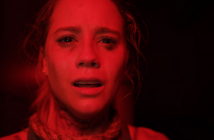Editor’s Notes: The following review is part of our coverage for TIFF’s Dreaming in Technicolor. For more information on this TIFF film series visit http://tiff.net and follow TIFF on Twitter at @TIFF_NET.
Ed Avery (James Mason) is a schoolteacher with secrets. For months, he’s been moonlighting as a taxi dispatcher to make ends meet, but he’s also been suffering from mysterious pains that he goes to great lengths to hide, especially from his wife Lou (Barbara Rush). Just as she’s starting to get suspicious, Ed collapses at home, and a trip to the hospital confirms he’s afflicted with a serious arterial disease. There is only one treatment: cortisone, which reduces inflammation and pain but is addictive and carries with it a host of serious side effects. The doctors don’t tell Ed about those side effects, however, and he leaves the hospital feeling terrific for the first time in years. Within days, however, he’s taking too much cortisone. His job, marriage, and little boy Ritchie (Christopher Olsen) suffer, and tragedy seems inevitable.
An almost Victorian account of struggle with mental and physical illness, superimposed with the relatively new — for the 1950s, anyway — concerns of the addictions and ill effects from the ever-increasing slate of drugs being prescribed to Americans.
Nicholas Ray’s Bigger Than Life (1956) is an almost Victorian account of struggle with mental and physical illness, superimposed with the relatively new — for the 1950s, anyway — concerns of the addictions and ill effects from the ever-increasing slate of drugs being prescribed to Americans. Because this is Nicholas Ray, however, more than just the medical issues are at stake here. Ed Avery is a man already afflicted long before the arterial disease strikes. He’s exhausted from keeping up appearances, from holding together a home life that doesn’t offer him much satisfaction, from doing everything he can to blend in, as society requires of him.
The strain of pretending as though everything is okay when it is absolutely, unequivocally not okay takes its toll on both his physical and mental health. His prim, porcelain-faced doll-wife Lou seems tailor made for this kind of society; a little quiver of the lip or a mild objection are about the best she can do when faced with any kind of problem, and it seems enough to satisfy her.
Ed isn’t cut out for the Mr. and Mrs. Suburban America lifestyle, though, and it shows long before he winds up in the hospital. It’s questionable whether his inevitable cortisone addiction induces his anger or merely heightens his already-existing contempt for society. Either way, his ego and temper get out of control, and soon he’s a sociopath, spouting ideas that at first seem reasonable, but quickly descend into madness.
If the finale of Bigger Than Life rings a little false, it’s because the film is in as much denial as the characters are.
This madness is indicated as much by the visuals in Bigger Than Life than the words. There is a similarity in Bigger Than Life‘s visual aesthetic to the color films of Alfred Hitchcock, though Hitchcock tended toward almost all shades of gray with small but effective splashes of bright, starched white and deep reds. Ray sticks to subtle colors, including little Ritchie’s red windbreaker, very similar to the jacket James Dean wore in Ray’s 1955 film Rebel Without a Cause, only not as bright.
The palette of the film is reminiscent of Ray’s other works of the period, with lots of browns, blues and greens that have been muted with gray. Sage green and teal are especially predominant, featuring in wardrobes and on the walls of the Avery home. In fact, blue lights are used in some shots to tone down setpieces that would otherwise stand out, and a few setpieces, such as throw pillows and curtains, are a white that has been dyed with a very light shade of teal. They read as white on screen, the blue only noticeable if those setpieces happen to end up next to true white. When madness strikes, this subdued palette remains, but a few shocks of color are thrown about and long, deep black shadows take over the edges and background of the frame.
Ray’s work in CinemaScope, especially on Bigger Than Life, has been criticized as lacking imagination and failing to use the vast spaces of widescreen effectively. Many point out that Bigger Than Life so frequently relies on centered single shots that the film could be easily cropped to Academy ratio, with the edges discarded as essentially wasted space.
Yet those centered shots, with the melodramatic lighting, complete with darkened edges to either side, highlight the internal, personal nature of the film’s conflicts, as well as the isolation of the characters, especially Ed Avery. While everyone in the film suffers, it’s only Ed who struggles for his soul, and it’s this abstract torment that is so keenly portrayed through the dull, almost blank visuals that surround Ed and his family.
These centered shots also visually code the Averys as normal, everyday folks who appear on the surface to have everything together. In fact, many shots in Bigger Than Life would fit right in on a television sitcom of the day. As Ed puts it, the Averys and everyone around them are “dull.” But Ed is not just dull; to be blunt, Ed is impotent, at least early in the film, and it’s the steroids coupled with a new lease on life that give him his virility back.
As much as Bigger Than Life means to tackle the issues of medical science outpacing the human ability to control these innovations, and as much as cortisone being described as a “miracle drug” is meant to be ironic, cortisone for Ed Avery is a miracle. This is a man who has spent his life stuck in a home that outside light cannot penetrate, full of posters of beautiful places around the world that he’ll never visit, with a wife who throws bridge parties “for” him when he never wanted those parties in the first place. He’s stifled and unhappy, so much so he’s hiding a second job and excruciating pain from a wife he, for reasons never stated, cannot (or will not) trust.
Those pills gave him a new lease on life, not just on his physical life but his emotional life. He’s learned in great big Technicolor terms that life is short, and it doesn’t have to be spent in a suburban hamlet being dull, avoiding your wife, and teaching kids who would rather spend their days watching shitty low-budget Westerns on their tiny televisions.
When Ed starts the cortisone, he also starts to get dreams for the future, and he’s got the intelligence and motivation to back those dreams up. But he’s cruel about it, too — whether the medication makes him cruel or takes away just enough inhibitions to allow his naturally cruel personality to show through, nobody knows — and in his drug-induced zeal he hurts those around him. More seriously, he tries to get out of responsibilities he took on years ago, the kind of things you can’t just leave behind even if you suddenly realize what your life calling has always been.
In some ways, those pills turned Ed not into a monster but into a man who could finally succeed. The film forces Ed’s family, and us, to confront the true price of the kind of success America has always promoted as being our shared cultural dream. But Bigger Than Life also forces us to confront the limitations that society, especially suburban society of the 1950s, forces on us, the little cubbyholes of acceptable behavior we must commit ourselves to lest we start to get the side-eye and slow-backing-away from those around us.
Again, Ed gets those responses because he is cruel, and because he can’t balance a healthy emotional and physical life with a healthy intellectual life. When he rails against his young son for being lazy, he is in no small part railing against himself, because somewhere underneath the drug-induced psychosis is a man who has discovered that he’s been lazy his whole life, and probably scared, too, unable to break free from pointless social constraints, the bridge parties and the small talk, and was only able to accept the kind of life he really wanted once his mind started to skew thanks to those life-saving pills.
And those pills do save his life. In a perverse way, the psychosis is saving his life. Those damnable pills are his psychological miracle, awakening in him the instinct of survival and the realization that it’s not the arterial disease that’s killing him but that tiny suburb, that small school, that dark house, and he was too lazy to stop it; only the accident of a cortisone addiction could save him. But Ed, for whatever reason — and to be sure, that reason could have been entirely out of his control — abused this miracle drug and all those around him. At the end of the day, even on those pills, he was too lazy and scared to fix himself, and instead tried to fix everyone else around him, like a goddamned coward.
If the finale of Bigger Than Life rings a little false, it’s because the film is in as much denial as the characters are. The campy nightmare of the final fight sequence doesn’t quite mesh with Ed’s dreamlike return to consciousness days later, and the prognosis of the doctors who, as François Truffaut famously noted, look just like gangsters, seems a little too reasonable given their previous behavior. It’s a makeshift finale, a temporary solution to a permanent problem, and an incongruous ending for a difficult and complicated film.
It's a makeshift finale, a temporary solution to a permanent problem, and an incongruous ending for a difficult and complicated film.




